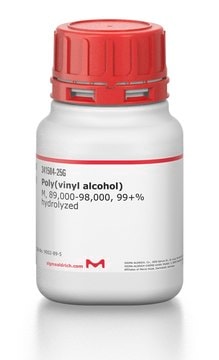340502
Poly(ethylene-co-vinyl acetate)
vinyl acetate 40 wt. %, melt index (41-63 dg/min (190°C/2.16kg)), contains 190-910 ppm inhibitor
Sinónimos:
PEVA
About This Item
Productos recomendados
Formulario
beads
Nivel de calidad
temp. de autoignición
500 °F
índice de fusión
(41-63 dg/min (190°C/2.16kg))
contiene
190-910 ppm inhibitor
composición
vinyl acetate, 40 wt. %
dureza
40 (Shore A-2, ASTM D 2240)
temperatura de transición
Tg −40-−30 °C
Tm 110-120 °C
solubilidad
toluene, THF, and MEK: soluble
cadena SMILES
C=C.CC(=O)OC=C
InChI
1S/C4H6O2.C2H4/c1-2-3-4(5)6;1-2/h2H,1,3H2,(H,5,6);1-2H2
Clave InChI
DQXBYHZEEUGOBF-UHFFFAOYSA-N
¿Está buscando productos similares? Visita Guía de comparación de productos
Categorías relacionadas
Descripción general
Aplicación
- Correlation between Cohesive Energy Density, Fractional Free Volume, and Gas Transport Properties: This study explores the properties of EVA materials that affect their gas permeability, important for applications like packaging and barrier materials (Kubica & Wolinska-Grabczyk, 2015).
- The Thermal and Mechanical Properties of EVA and its Crosslinked Analogues: This research investigates how crosslinking affects the thermal and mechanical properties of EVA, which could interest material scientists working with polymers (Wang & Deng, 2019).
- Investigation of morphological, rheological, and mechanical properties of cyclic olefin copolymer/EVA blend films: This study focuses on the blend properties of EVA with other polymers, providing insights useful in academia and material science (Durmus et al., 2018).
- Fabrication, characterization, and properties of EVA/magnetite nanocomposites: Relevant to material scientists, this research discusses the incorporation of magnetite nanoparticles into EVA for enhanced properties (Ramesan, 2014).
Código de clase de almacenamiento
11 - Combustible Solids
Clase de riesgo para el agua (WGK)
nwg
Punto de inflamabilidad (°F)
Not applicable
Punto de inflamabilidad (°C)
Not applicable
Equipo de protección personal
Eyeshields, Gloves, type N95 (US)
Elija entre una de las versiones más recientes:
¿Ya tiene este producto?
Encuentre la documentación para los productos que ha comprado recientemente en la Biblioteca de documentos.
Artículos
Electrospinning technique applications discussed, emphasizing control of nanofibers and assembly into 3D architectures.
Electrospinning technique applications discussed, emphasizing control of nanofibers and assembly into 3D architectures.
Electrospinning technique applications discussed, emphasizing control of nanofibers and assembly into 3D architectures.
Electrospinning technique applications discussed, emphasizing control of nanofibers and assembly into 3D architectures.
Nuestro equipo de científicos tiene experiencia en todas las áreas de investigación: Ciencias de la vida, Ciencia de los materiales, Síntesis química, Cromatografía, Analítica y muchas otras.
Póngase en contacto con el Servicio técnico


![[1R-(2-endo,3-exo)]-3-Hydroxy-4,7,7-trimethylbicyclo[2.2.1]heptane-2-acetic acid 99%](/deepweb/assets/sigmaaldrich/product/structures/302/015/ab0ad101-2636-4430-bd07-e61d744f6817/640/ab0ad101-2636-4430-bd07-e61d744f6817.png)



